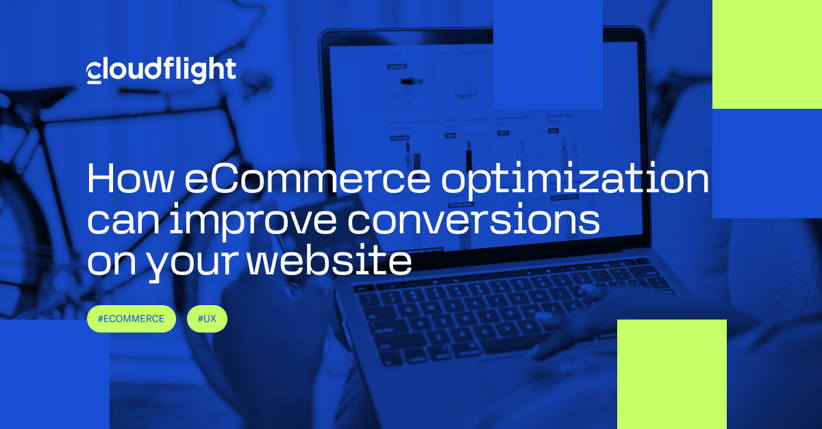As soon as your customers land on your website, their journey from A to B (exploration to purchase) should be as simple as possible. The easier it is to navigate your eCommerce website, the more enjoyable their experience with your brand, and the more likely they are to buy something.
With that in mind, it should come as no surprise that investing in eCommerce optimization is going to pay dividends when it comes to turning scrollers into buyers. Ultimately, the more intuitive your website, the more sales you’ll make.
Let’s have a look at how professional eCommerce optimization can improve conversions on your website.
What is eCommerce CRO?
Before we jump in, let’s set the score regarding eCommerce conversion rate optimization (CRO). eCommerce CRO relates to the amount of website visitors who purchased or “did something,” such as subscribed to an email list, completed a form, etc., from your online store. This can happen on any page too, including your home page and any landing page.
Here are a few examples of an eCommerce conversion:
- A sale from your online store.
- Adding products to your online basket.
- Subscribing to an email or newsletter list.
- Social media shares.
Essentially, the conversion rate can be anything you believe to be a conversion on your website.
What is a good eCommerce conversion rate?
The term “well, that depends” comes to mind here. It’s hard to state what a good conversion rate across all industries would be because it varies significantly based on the industry, target audience, and the complexity of the products or services offered.
However, on average, a good eCommerce conversion rate is around 2.5-3%. This might not sound like a lot, but it represents a solid benchmark for many eCommerce businesses.
Achieving and maintaining a conversion rate within this range indicates a healthy balance between attracting visitors and convincing them to make a purchase. No site gets everything perfect, and you’ll find yourself constantly chopping and changing your CRO strategy to keep up with the evolving marketing landscape and consumer behaviors. Plus, when you take the time to analyze the issues that your customers are facing when buying products on your site and fixing them, you’ll see your CRO rise and your abandonment rate fall.
Checklist for improving your eCommerce CRO
Let’s look at the best ways to leverage eCommerce optimization to maximize your conversion rate.
Identify your ideal web visitor and target them
Knowing who your target audience is makes it much easier to sell your product to them. Tools like Google Analytics give you basic but crucial insights into important audience information, like their age, gender, location, and other demographics.
From here, you can tailor everything from your user experience (UX) to your content in order to align with their interests and alleviate their pain points. The more you understand your visitors, the better equipped you are to address their needs.
Make your funnel for traffic easy to navigate
Once you’ve identified your target audience, your next job is to ensure your eCommerce website is easy to navigate. You could have a beautiful online store you’ve spent thousands on, but if it feels like a maze to navigate, chances are your visitors will leave.
This is where UX comes into play. UX strategies differ depending on industry and specific audience requirements, but in general, creating a great user experience includes:
- The use of high-quality imagery.
- Effortless navigation through your online store, including buttons in the right places, easy-to-find pages, and an overall clear structure.
- Social proof to reaffirm visitor intent to buy.
- Solid UX design.
- Simple product page layout
It’s also worth assessing the quality and performance of your hosting. Managed hosting can help speed up your website, enhance your site’s security, provide add-ons, like backups and email integration, and last but not least, support. Should you run into any issues with your eCommerce website, your hosting provider should be able to provide a solution.
Be sure to have your website optimized for mobile, too!
Simplify your checkout process
The next step in optimizing your online store is to ensure the final stage of your visitors’ journey is as simple as possible. This includes clear labels, buttons, scrolling functions, call-to-actions, and clear and concise copy. All of this should ensure that, as well as the checkout process being easy to navigate, it’s also fast. No one wants to muddle through several steps to buy their desired product or service.
If you have a particularly complex product or the checkout process has to be lengthy, think about ways you can make it easier for buyers. Displaying progress bars to show them how close they are to completion is a popular method.
Be sure to include a few different payment options too, and include the most trusted platforms. PayPal, SumUp, Apple Pay, and Klarna are among some of the most popular.
Last but not least, ensure the checkout process is secure, and add some trust symbols. It can become quite disconcerting if your website asks for too much personal information. Having security badges, such as locks on SSL certificates and recognized payment logos, increases your visitors’ confidence when purchasing.
Use live chat and chatbots
There has been a substantial increase in the number of businesses using live chat and chatbots to streamline their users’ experiences with their websites. There's a good reason for this too. Not only does it make your life as a virtual store owner a lot easier, but your customers will appreciate getting instant feedback at the press of a key.
For example, when customers have questions about product features, availability, or order status, live chat and chatbots provide an immediate avenue for clarification. This instant accessibility not only enhances customer satisfaction but also contributes to higher conversion rates because potential buyers can receive real-time assistance during their decision-making process.
Additionally, the efficiency of live chat and chatbots extends beyond business hours. Customers appreciate the convenience of obtaining assistance 24/7 that accommodates various time zones and schedules. This constant availability contributes to a more customer-centric approach by demonstrating a commitment to meeting the diverse needs of a global audience.
Consider investing in heatmap tools
Heat mapping tools offer visual insights into user behavior on websites. Lucky Orange is one of the most popular tools, and it works by generating heat maps that vividly highlight popular and less-engaged areas based on real user interactions.
From there, you can gain a better understanding of user interactions, including mouse movements, clicks, and scrolling behavior. This is particularly important if you find visitors are dropping out on your core landing or payment pages.
The replay feature allows you to spot specific points of interest or potential friction within the user experience to identify exactly where users engage, hesitate, or disengage. This allows for targeted optimizations.
Always be A/B testing
A/B testing is one of the best ways to evaluate and compare different versions of web pages or specific elements for the best conversion rates. This includes product descriptions, images, or call-to-action buttons. By presenting users with distinct variations (A and B) and measuring their responses, you can gain valuable insights into the performance of different design or content elements.
For example, with A/B testing you can test variations in your product descriptions to determine which messaging prompts more engagement. You’ll able to experiment with the placement and color of call-to-action buttons to understand their impact on conversion rates.
It might also be worth organizing a site audit. By doing so, you’ll be able to identify areas of improvement and make the necessary changes to enhance the overall performance and conversion rate of your website.
Takeaways
Investing in eCommerce optimization is essential if you’re looking to turn scrollers into buyers. You may have the best products on the market, but if your visitors are struggling to navigate your website or bouncing off your landing pages, this is where you need to rethink your CRO strategy.
The CRO methods above will offer a great foundation to start converting your current traffic into certified leads. The key is consistency and regularly analyzing data, feedback, and performance metrics. You always need to have your finger on the pulse to keep improving your CRO efforts in this industry.
To ensure you don’t trip up in your CRO efforts, be sure to avoid these 7 CRO mistakes.
Published January 23, 2024











